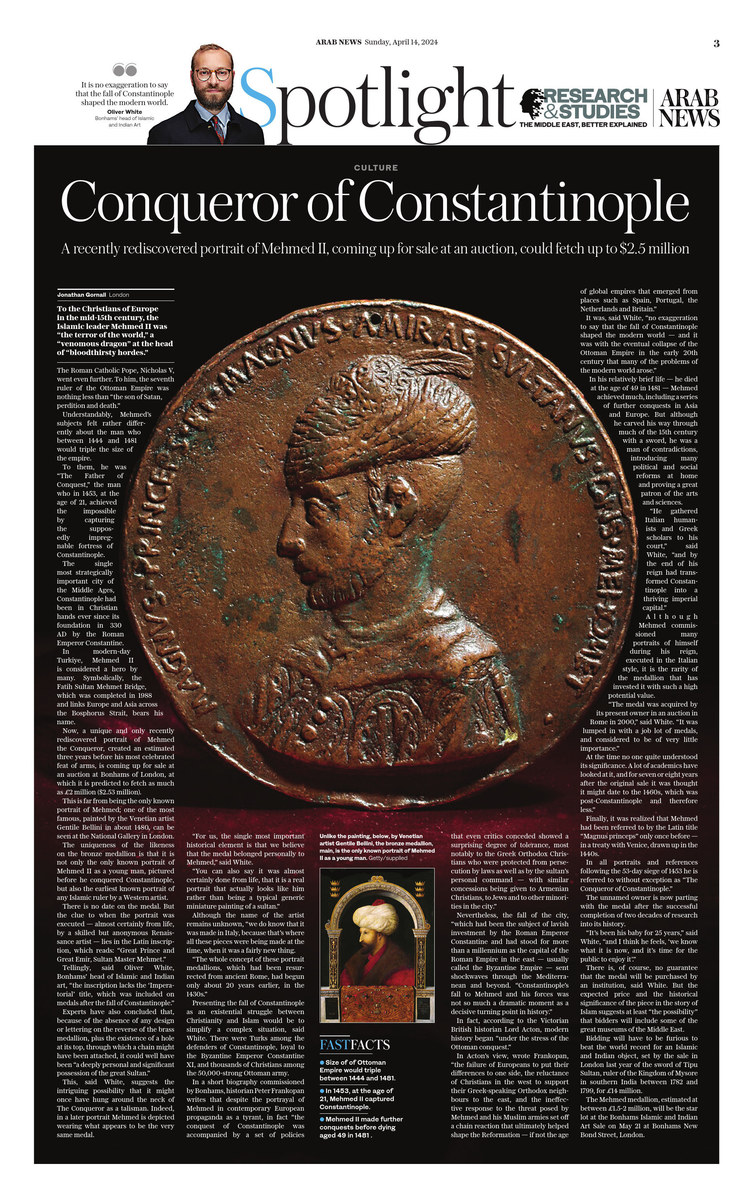LONDON: To the Christians of Europe in the mid-15th century, the Islamic leader Mehmed II was “the terror of the world,” a “venomous dragon” at the head of “bloodthirsty hordes.”
The Roman Catholic Pope, Nicholas V, went even further. To him, the seventh ruler of the Ottoman Empire was nothing less than “the son of Satan, perdition and death.”
Understandably, Mehmed’s subjects felt rather differently about the man who between 1444 and 1481 would triple the size of the empire.
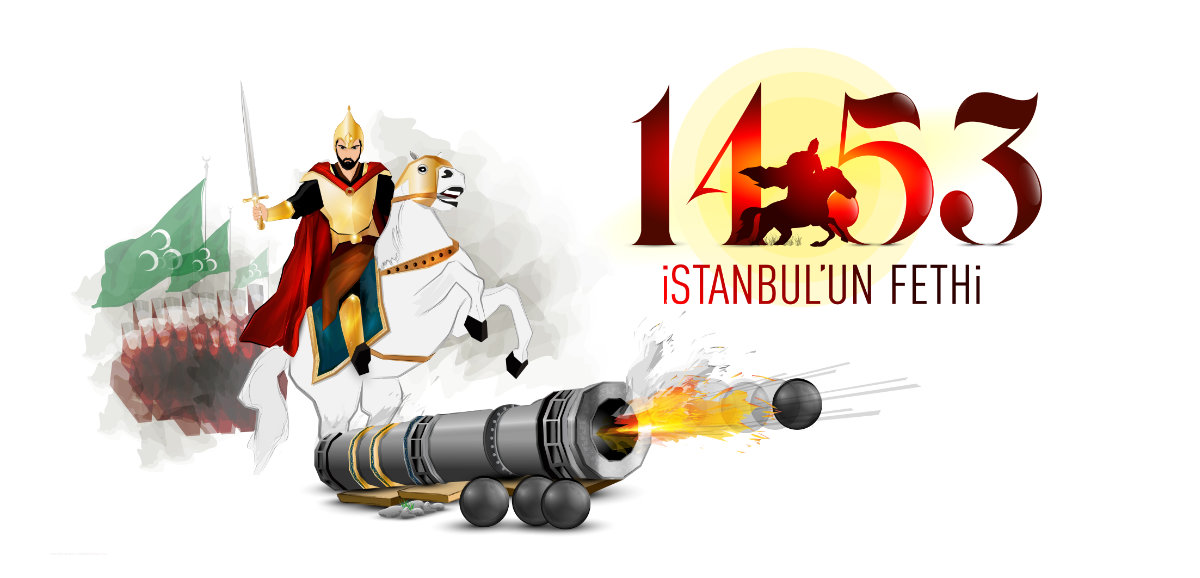
Illustration showing Mehmed II, the Conqueror of Constantinople. (Shutterstock)
To them, he was “The Father of Conquest,” the man who in 1453, at the age of 21, achieved the impossible by capturing the supposedly impregnable fortress of Constantinople.
The single most strategically important city of the Middle Ages, Constantinople had been in Christian hands ever since its foundation in 330 AD by the Roman Emperor Constantine.
In modern-day Turkiye, Mehmed II is considered a hero by many. Symbolically, the Fatih Sultan Mehmet Bridge, which was completed in 1988 and links Europe and Asia across the Bosphorus Strait, bears his name.
Now, a unique and only recently rediscovered portrait of Mehmed the Conqueror, created an estimated three years before his most celebrated feat of arms, is coming up for sale at an auction at Bonhams of London, at which it is predicted to fetch as much as £2 million ($2.53 million).
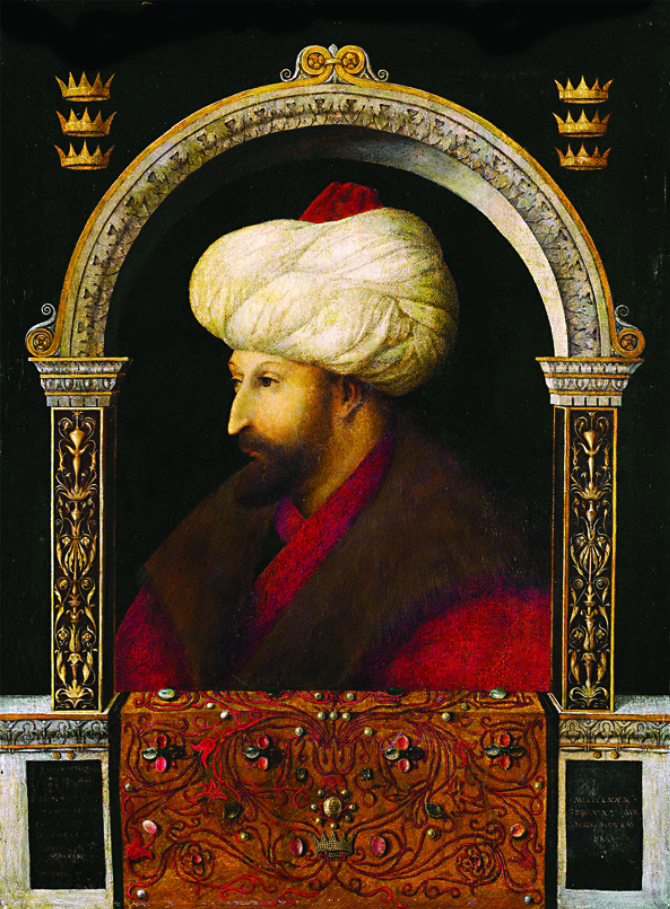
This painting of Mehmed the Conqueror by Venetian artist Gentile Bellini in about 1480 can be seen at the National Gallery in London. (Supplied)
This is far from being the only known portrait of Mehmed; one of the most famous, painted by the Venetian artist Gentile Bellini in about 1480, can be seen at the National Gallery in London.
The uniqueness of the likeness on the bronze medallion is that it is not only the only known portrait of Mehmed II as a young man, pictured before he conquered Constantinople, but also the earliest known portrait of any Islamic ruler by a Western artist.
There is no date on the medal. But the clue to when the portrait was executed — almost certainly from life, by a skilled but anonymous Renaissance artist — lies in the Latin inscription, which reads: “Great Prince and Great Emir, Sultan Master Mehmet.”
Tellingly, said Oliver White, Bonhams’ head of Islamic and Indian art, “the inscription lacks the ‘Imperatorial’ title, which was included on medals after the fall of Constantinople.”
Experts have also concluded that, because of the absence of any design or lettering on the reverse of the brass medallion, plus the existence of a hole at its top, through which a chain might have been attached, it could well have been “a deeply personal and significant possession of the great Sultan.”
FASTFACTS
• Size of of Ottoman Empire would triple between 1444 and 1481.
• In 1453, at the age of 21, Mehmed II captured Constantinople.
• Mehmed II made further conquests before dying aged 49 in 1481 .
This, said White, suggests the intriguing possibility that it might once have hung around the neck of The Conqueror as a talisman. Indeed, in a later portrait Mehmed is depicted wearing what appears to be the very same medal.
“For us, the single most important historical element is that we believe that the medal belonged personally to Mehmed,” said White.
“You can also say it was almost certainly done from life, that it is a real portrait that actually looks like him rather than being a typical generic miniature painting of a sultan.”
Although the name of the artist remains unknown, “we do know that it was made in Italy, because that’s where all these pieces were being made at the time, when it was a fairly new thing.
“The whole concept of these portrait medallions, which had been resurrected from ancient Rome, had begun only about 20 years earlier, in the 1430s.”
Presenting the fall of Constantinople as an existential struggle between Christianity and Islam would be to simplify a complex situation, said White. There were Turks among the defenders of Constantinople, loyal to the Byzantine Emperor Constantine XI, and thousands of Christians among the 50,000-strong Ottoman army.
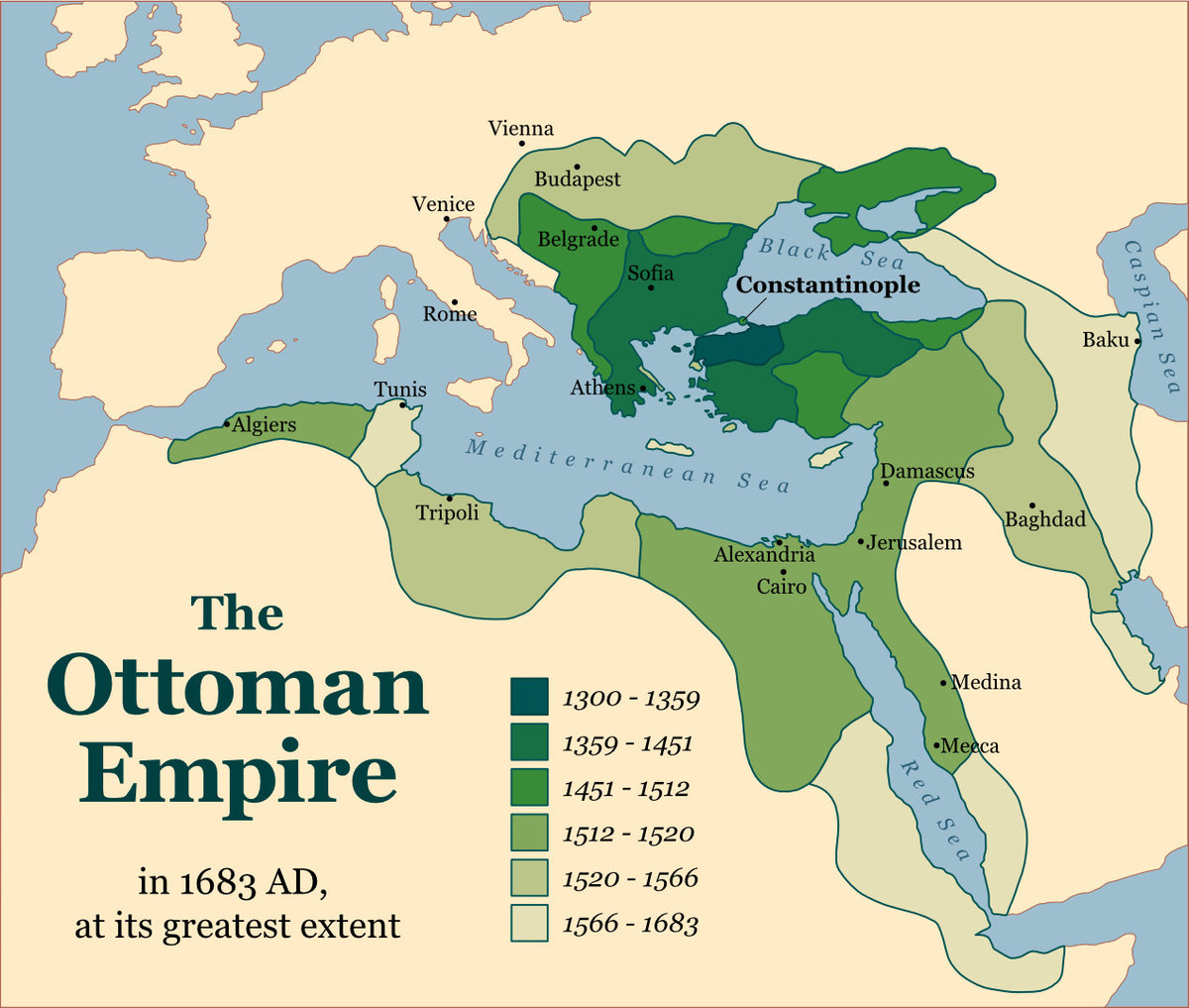
Shutterstock image
In a short biography commissioned by Bonhams, historian Peter Frankopan writes that despite the portrayal of Mehmed in contemporary European propaganda as a tyrant, in fact “the conquest of Constantinople was accompanied by a set of policies that even critics conceded showed a surprising degree of tolerance, most notably to the Greek Orthodox Christians who were protected from persecution by laws as well as by the sultan’s personal command — with similar concessions being given to Armenian Christians, to Jews and to other minorities in the city.”
Nevertheless, the fall of the city, “which had been the subject of lavish investment by the Roman Emperor Constantine and had stood for more than a millennium as the capital of the Roman Empire in the east — usually called the Byzantine Empire — sent shockwaves through the Mediterranean and beyond.
“Constantinople’s fall to Mehmed and his forces was not so much a dramatic moment as a decisive turning point in history.”
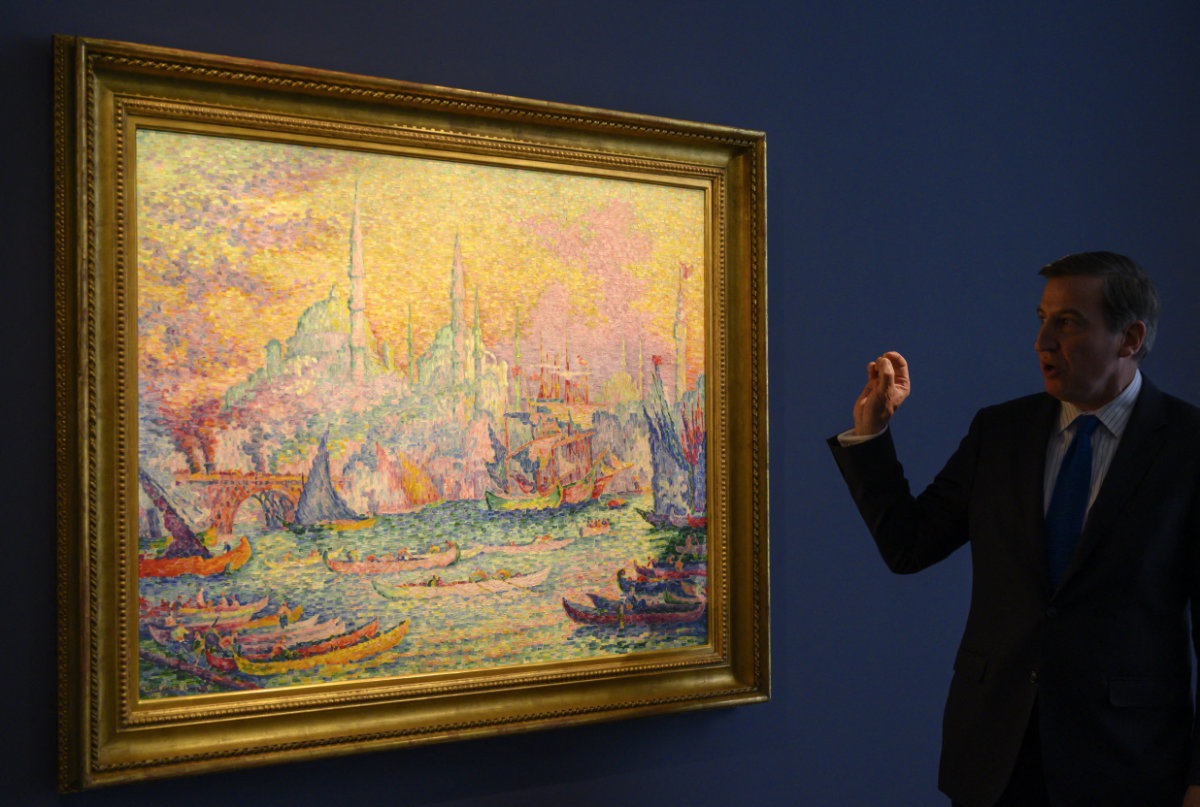
Art experts from Sotheby's talk about Paul Signac's "La Corne d'Or (Constantinople)" during an auction preview November 1, 2019 at Sotheby's in New York. (AFP/File photo)
In fact, according to the Victorian British historian Lord Acton, modern history began “under the stress of the Ottoman conquest.”
In Acton’s view, wrote Frankopan, “the failure of Europeans to put their differences to one side, the reluctance of Christians in the west to support their Greek-speaking Orthodox neighbours to the east, and the ineffective response to the threat posed by Mehmed and his Muslim armies set off a chain reaction that ultimately helped shape the Reformation — if not the age of global empires that emerged from places such as Spain, Portugal, the Netherlands and Britain.”
It was, said White, “no exaggeration to say that the fall of Constantinople shaped the modern world — and it was with the eventual collapse of the Ottoman Empire in the early 20th century that many of the problems of the modern world arose.”
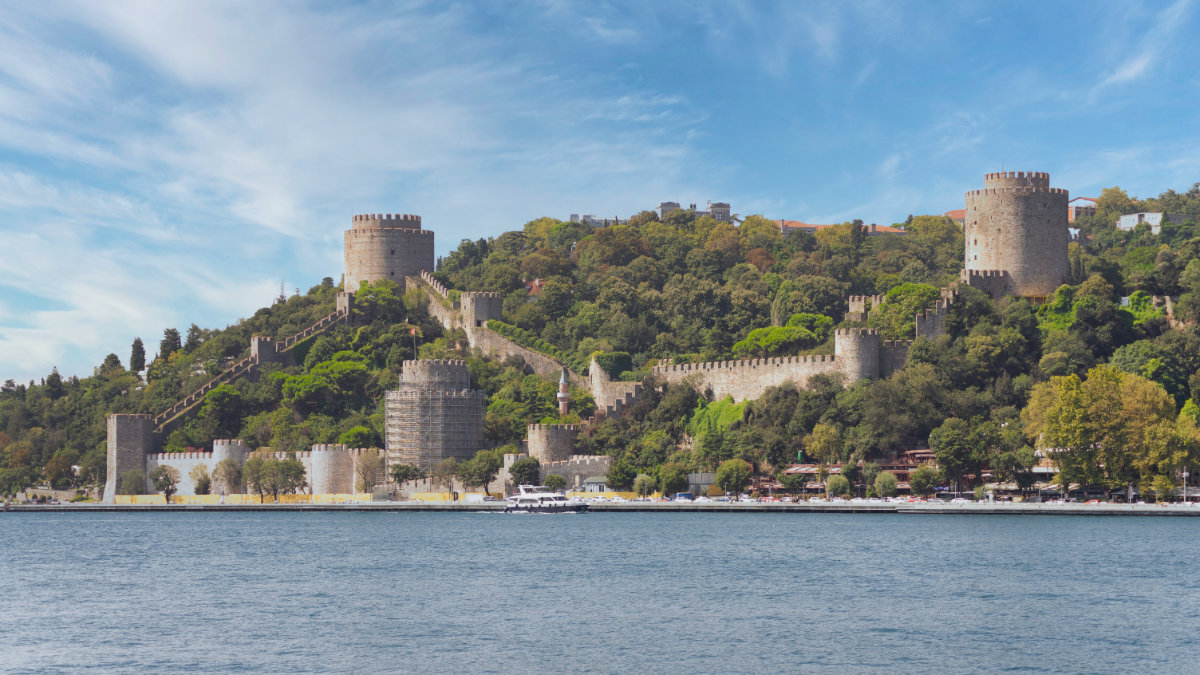
Ruins of Rumelihisari, Bogazkesen Castle, or Rumelian Castle, built by Ottoman Sultan Mehmed II. located at the hills of the European side of Bosphorus Strait, Istanbul, Turkiye. (Shutterstock image)
In his relatively brief life — he died at the age of 49 in 1481 — Mehmed achieved much, including a series of further conquests in Asia and Europe. But although he carved his way through much of the 15th century with a sword, he was a man of contradictions, introducing many political and social reforms at home and proving a great patron of the arts and sciences.
“He gathered Italian humanists and Greek scholars to his court,” said White, “and by the end of his reign had transformed Constantinople into a thriving imperial capital.”
Although Mehmed commissioned many portraits of himself during his reign, executed in the Italian style, it is the rarity of the medallion that has invested it with such a high potential value.
“The medal was acquired by its present owner in an auction in Rome in 2000,” said White. “It was lumped in with a job lot of medals, and considered to be of very little importance.”
At the time no one quite understood its significance. A lot of academics have looked at it, and for seven or eight years after the original sale it was thought it might date to the 1460s, which was post-Constantinople and therefore less.”
Finally, it was realized that Mehmed had been referred to by the Latin title “Magnus princeps” only once before — in a treaty with Venice, drawn up in the 1440s.
In all portraits and references following the 53-day siege of 1453 he is referred to without exception as “The Conqueror of Constantinople.”
ALSO READ: Book by Saudi author unravels Ottoman atrocities in Madinah
The unnamed owner is now parting with the medal after the successful completion of two decades of research into its history.
“It’s been his baby for 25 years,” said White, “and I think he feels, ‘we know what it is now, and it's time for the public to enjoy it’.”
There is, of course, no guarantee that the medal will be purchased by an institution, said White. But the expected price and the historical significance of the piece in the story of Islam suggests at least “the possibility” that bidders will include some of the great museums of the Middle East.

Tipu Sultan's fabled bedchamber sword sold for £14 million at Bonhams Islamic and Indian Art sale in London on May 23, 2023. (Photo credit: Bonhams)
Bidding will have to be furious to beat the world record for an Islamic and Indian object, set by the sale in London last year of the sword of Tipu Sultan, ruler of the Kingdom of Mysore in southern India between 1782 and 1799, for £14 million.
The Mehmed medallion, estimated at between £1.5-2 million, will be the star lot at the Bonhams Islamic and Indian Art Sale on May 21 at Bonhams New Bond Street, London.
